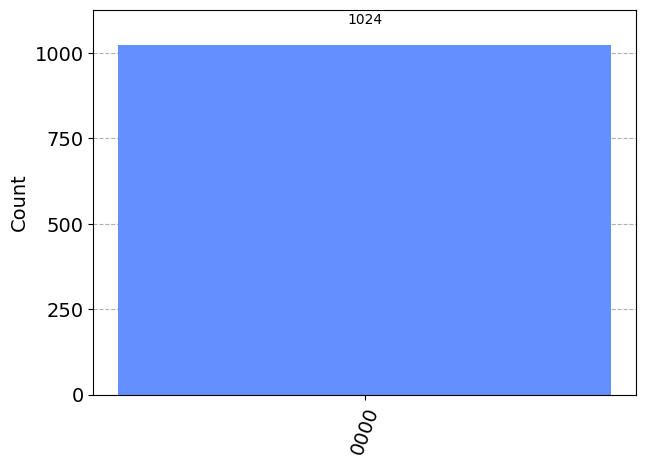# Needed to set up the quantum circuit
from qiskit import QuantumCircuit, ClassicalRegister, QuantumRegister
# Needed to simulate running a quantum computer
from qiskit_aer import AerSimulator
# Neded to visualize the results of running a quantum computer
from qiskit.visualization import plot_histogramLecture 9 Example Solutions
Note that the below solutions are only examples, there are many possible solutions to each challenge.
For each of the below challenge questions:
- Draw (by hand) the predicted quantum circuit that is needed to achieve the desired results
- Use
qiskitto build the quantum circuit and ensure that qiskit circuit matches your predicted circuit - Use
Aerto simulate the circuit and ensure you get the desired results. Remember that when mapping from qubits to classical bits \(|\uparrow\rangle\) = 0 and \(|\downarrow\rangle\) = 1.
Challenge 1
Create a circuit that creates the state \(|\uparrow\uparrow\uparrow\uparrow\rangle\) only and that uses two or more gates.
q = QuantumRegister(4)
c = ClassicalRegister(4)
qc = QuantumCircuit(q,c)
qc.z(0)
qc.z(0)
qc.z(0)
qc.measure(q,c)
print(qc.draw())
simulator = AerSimulator()
results = simulator.run(qc).result().get_counts()
plot_histogram(results) ┌───┐┌───┐┌───┐┌─┐
q3_0: ┤ Z ├┤ Z ├┤ Z ├┤M├
└┬─┬┘└───┘└───┘└╥┘
q3_1: ─┤M├────────────╫─
└╥┘ ┌─┐ ║
q3_2: ──╫───┤M├───────╫─
║ └╥┘ ┌─┐ ║
q3_3: ──╫────╫───┤M├──╫─
║ ║ └╥┘ ║
c2: 4/══╩════╩════╩═══╩═
1 2 3 0 
Challenge 2
Create the state \(|\uparrow\downarrow\downarrow\downarrow\uparrow\rangle\) using the Fredkin gate and any number of other gates.
q = QuantumRegister(5)
c = ClassicalRegister(5)
qc = QuantumCircuit(q,c)
qc.x(1)
qc.x(2)
qc.x(3)
qc.cswap(1,2,3)
qc.measure(q,c)
print(qc.draw())
simulator = AerSimulator()
results = simulator.run(qc).result().get_counts()
plot_histogram(results) ┌─┐
q4_0: ─────┤M├────────────
┌───┐└╥┘ ┌─┐
q4_1: ┤ X ├─╫──■─┤M├──────
├───┤ ║ │ └╥┘┌─┐
q4_2: ┤ X ├─╫──X──╫─┤M├───
├───┤ ║ │ ║ └╥┘┌─┐
q4_3: ┤ X ├─╫──X──╫──╫─┤M├
└┬─┬┘ ║ ║ ║ └╥┘
q4_4: ─┤M├──╫─────╫──╫──╫─
└╥┘ ║ ║ ║ ║
c3: 5/══╩═══╩═════╩══╩══╩═
4 0 1 2 3 
Challenge 3
Create a circuit that produces \(|\downarrow\uparrow\uparrow\downarrow\rangle\) and at least one other state.
q = QuantumRegister(4)
c = ClassicalRegister(4)
qc = QuantumCircuit(q,c)
qc.x(0)
qc.x(3)
qc.h(1)
qc.measure(q,c)
print(qc.draw())
simulator = AerSimulator()
results = simulator.run(qc).result().get_counts()
plot_histogram(results) ┌───┐ ┌─┐
q6_0: ┤ X ├───┤M├──────
├───┤ └╥┘┌─┐
q6_1: ┤ H ├────╫─┤M├───
└───┘┌─┐ ║ └╥┘
q6_2: ─────┤M├─╫──╫────
┌───┐└╥┘ ║ ║ ┌─┐
q6_3: ┤ X ├─╫──╫──╫─┤M├
└───┘ ║ ║ ║ └╥┘
c5: 4/══════╩══╩══╩══╩═
2 0 1 3 
Challenge 4
Create a circuit which has only one possible outcome (\(|\downarrow\uparrow\downarrow\uparrow\downarrow\rangle\)) using at most one single qubit gate and any number of two and three qubit gates.
q = QuantumRegister(5)
c = ClassicalRegister(5)
qc = QuantumCircuit(q,c)
qc.x(0)
qc.cx(0,2)
qc.cx(0,4)
qc.measure(q,c)
print(qc.draw())
simulator = AerSimulator()
results = simulator.run(qc).result().get_counts()
plot_histogram(results) ┌───┐ ┌─┐
q14_0: ┤ X ├──■────■─────┤M├───
└┬─┬┘ │ │ └╥┘
q14_1: ─┤M├───┼────┼──────╫────
└╥┘ ┌─┴─┐ │ ┌─┐ ║
q14_2: ──╫──┤ X ├──┼──┤M├─╫────
║ └┬─┬┘ │ └╥┘ ║
q14_3: ──╫───┤M├───┼───╫──╫────
║ └╥┘ ┌─┴─┐ ║ ║ ┌─┐
q14_4: ──╫────╫──┤ X ├─╫──╫─┤M├
║ ║ └───┘ ║ ║ └╥┘
c13: 5/══╩════╩════════╩══╩══╩═
1 3 2 0 4 
Challenge 5
An \(n\) qubit circuit has \(2^n\) possible combinations of qubits (\(2^n\) possible qubits). Create a 5 qubit circuit that has at least 6 possible outcomes. You must use two different types gates in addition to any number of Hadamard gates.
q = QuantumRegister(5)
c = ClassicalRegister(5)
qc = QuantumCircuit(q,c)
qc.h(0)
qc.h(2)
qc.h(4)
qc.measure(q,c)
print(qc.draw())
simulator = AerSimulator()
results = simulator.run(qc).result().get_counts()
plot_histogram(results) ┌───┐ ┌─┐
q48_0: ┤ H ├──────┤M├──────
└───┘┌─┐ └╥┘
q48_1: ─────┤M├────╫───────
┌───┐└╥┘ ║ ┌─┐
q48_2: ┤ H ├─╫─────╫─┤M├───
└───┘ ║ ┌─┐ ║ └╥┘
q48_3: ──────╫─┤M├─╫──╫────
┌───┐ ║ └╥┘ ║ ║ ┌─┐
q48_4: ┤ H ├─╫──╫──╫──╫─┤M├
└───┘ ║ ║ ║ ║ └╥┘
c47: 5/══════╩══╩══╩══╩══╩═
1 3 0 2 4 